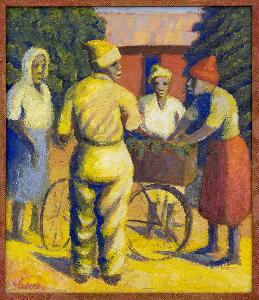Gerard Sekoto
Gerard Sekoto
Style: Expressionism; Social Realism;
Place: Botshabelo
Born: 1913
Death: 1993
Biography:
Gerard Sekoto was a South African artist and musician. He is recognized as a pioneer of urban black art and social realism. His work was exhibited in Paris, Stockholm, Venice, Washington, and Senegal, as well as in South Africa. Sekoto was born in Botshabelo, Mpumalanga, South Africa in 1913. He was the son of Andreas Sekoto, a leading member of the new Christian converts. Sekoto was schooled at Wonderhoek, which was established by his father, a priest and teacher. As the son of a missionary, he experienced music as a part of his life and was introduced to the family harmonium at an early age. Sekoto's art skills emerged in his teenage years, when he attended the Diocesan Teachers Training College in Pietersburg. He graduated as a teacher from the Diocesan Teachers Training College in Pietersburg and taught at a local school, Khaiso Secondary, for four years. During this time he entered an art competition (the May Esther Bedford) organised by the Fort Hare University, for which he was awarded second prize. In 1938 at the age of 25 he left for Johannesburg to pursue a career as an artist. He held his first solo exhibition in 1939. In 1940 the Johannesburg Art Gallery purchased one of his pictures; it was to be the first picture painted by a black artist to enter a museum collection. In 1942 he moved to District Six in Cape Town, where he lived with the Manuel family. Here he apparently met George Pemba (1912–2001), (qv.) who was visiting from Port Elizabeth. In 1945 he moved to Eastwood, Pretoria. During this time, Sekoto lived with his mother, stepfather, and brother. It has been said that some of Sekoto's most beloved work is from this time, and has been deemed 'the golden years of his art'. The reason being that this was the last body of work he completed in South Africa, before going to Paris. In 1947 he left South Africa to live in Paris under self-imposed exile. He died in Paris in 1993.





